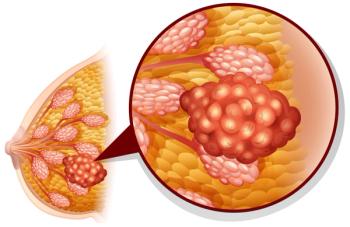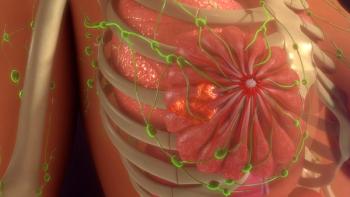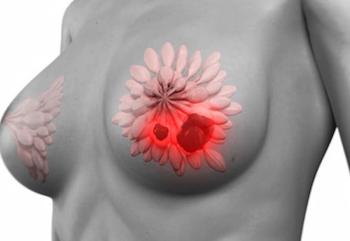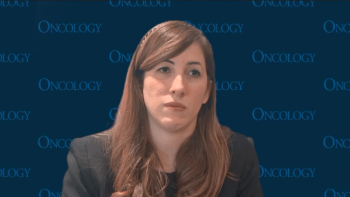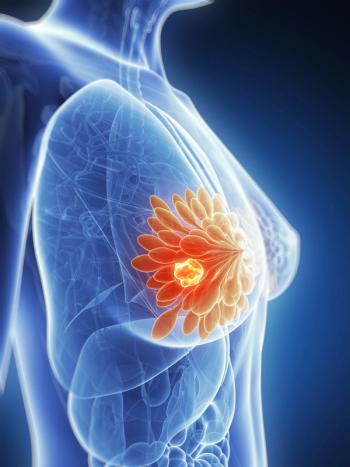
- ONCOLOGY Vol 15 No 2
- Volume 15
- Issue 2
Gemcitabine/Epirubicin/Paclitaxel Trials in Advanced Breast Cancer
Numerous trials have shown that the pharmacokinetic interferences of epirubicin (Ellence)/paclitaxel (Taxol) combinations produce less pharmacodynamic effect than doxorubicin/paclitaxel regimens. Paclitaxel is more easily
ABSTRACT: Numerous trials have shown that the pharmacokineticinterferences of epirubicin (Ellence)/paclitaxel (Taxol) combinations produceless pharmacodynamic effect than doxorubicin/paclitaxel regimens. Paclitaxel ismore easily combined when infused over 3 (as compared to 24) hours; theadministration of optimal doses of both agents is important. Based on thesefindings, a phase II study was performed to evaluate the feasibility andactivity of the combination of gemcitabine (Gemzar), epirubicin, and paclitaxelas first-line therapy in advanced breast cancer. Patients received gemcitabineat 1,000 mg/m2 on days 1 and 4, plus epirubicinat 90 mg/m2 on day 1, plus paclitaxel at 175mg/m2/d on day 1 every 21 days. After sixcourses, patients less than 60 years old and in complete or partial remission orstable disease were treated with high-dose chemotherapy as consolidationtreatment. The overall response rate was 92%, with 31% complete responses; 25patients received high-dose chemotherapy, achieving a final overall responserate of 97%, with 47% complete responses. At a median follow-up of 25 months,median progression-free survival is 21 months. Grade 4 neutropenia was observedin 64% of patients. Other hematologic toxicities were mild. Mild to moderateperipheral neuropathy was experienced by 39% of patients; grade 2 or 3 mucositisoccurred in 25% and 17% of patients, respectively. Based on these results, amulticenter trial has been started in seven Italian centers to confirm thefeasibility of this regimen. [ONCOLOGY 15(Suppl 3):41-43, 2001]
Introduction
Metastatic breast cancer is considered anincurable disease, with a median overall survival of 18 to 24 months and a5-year survival ranging from 3% to 12%. Even if chemotherapy can induce highresponse rates, its main objective is symptom palliation. However, patients whoachieve a complete response to first-line chemotherapy can become long-termsurvivors. Of the many cytotoxic drugs tested in metastatic breast cancer,anthracyclines have shown superior activity. For this reason,anthracycline-based regimens are considered the standard of care.[1]
Both FAC (fluorouracil [5-FU]/doxorubicin[Adriamycin]/cyclophosphamide [Cytoxan, Neosar]) and CEF(cyclophosphamide/fluorouracil/epirubicin [Ellence]), the commonly usedanthracycline-based regimens, produce response rates of 50% to 60%. However,only 10% to 20% of patients achieve a complete response. Interestingly, amongcomplete response patients, 18% remain disease-free for more than 5 years, and10% are alive for more than 20 years.[2,3] Therefore, the availability of newactive agents and new combinations might improve the outcome of patients withmetastatic breast cancer.
The possible strategies to introduce a new agent are either thedevelopment of new combination regimens or the sequential administration ofactive agents at full doses. The latter approach is based on a theoretical modelpredicting that tumor-cell killing is maximized with the sequentialadministration of non-cross-resistant drugs. The feasibility of this methodhas been proven in high-risk, early breast cancer; the concept of dose-densesequential treatment is being tested in metastatic breast cancer patients. Anongoing study of our cooperative group, Gruppo Oncologico Nord Ovest (GONO),compares eight courses of epirubicin given in combination with paclitaxel(Taxol) with four doses of epirubicin followed by four doses of paclitaxel.
Anthracycline/Taxane Trials
Clearly, if combination regimens can be administered withindividual drugs given at optimal dose, the complete response rate may increase,and hopefully, more long-term survivors will be observed. Thus, based on highactivity and incomplete cross resistance, several trials have evaluated thefeasibility and toxicity of anthracyclines combined with taxanes. The resultsfrom nonrandomized phase II trials have shown that this association is veryactive; overall response rates range from 75% to 95%, with complete responserates as high as 40%.[4-6]
In particular, the combination epirubicin and paclitaxel (Taxol)(ET) can be administered at optimal doses with a response rate of 84%, whichincludes a 19% complete response rate.[7] We have also shown thatpharmacokinetic interactions between epirubicin and paclitaxel could account forthe activity and toxicity of this association.[8]
Phase III Trials
These results have been partially confirmed by recently reportedphase III randomized studies. A large, randomized Eastern Cooperative OncologyGroup trial has shown that, in terms of activity and time to disease progressionwithout any survival advantage, the combination of doxorubicin (Adriamycin) pluspaclitaxel (Taxol) (AT) administered over 24 hours is significantly superior todoxorubicin or paclitaxel given as single agents.[9]
A French Canadian study (TAX 306) comparing AC (doxorubicin[Adriamycin]/cyclophosphamide) vs AD (doxorubicin/docetaxel [Taxotere]) showeda significant increase in overall response rate and progression-free survivalfor the AD arm.[10] These data have been recently confirmed by an EasternEuropean trial where patients were randomized to receive either FAC or AT,showing a significant increase in both overall and progression-free survival forthe AT arm.[11]
Finally, a German trial of ET vs EC(epirubicin/cyclophosphamide) reported a slight increase in time to progressionin favor of ET with no difference in overall response rates.[12] A EuropeanOrganization for Research and Treatment of Cancer (EORTC) trial of AT vs ACshowed no difference in overall response rates and progression-freesurvival.[13]
Unfortunately, the complete response rates in all these trialswere lower than expected. There are some possible reasons why theanthracycline/taxane combinations have shown only a slight superiority over theanthracycline/alkylator combinations. First, it may be due to negativepharmacokinetic interactions between doxorubicin and paclitaxel. A secondpossibility is the administration of suboptimal doses (in particular in theEORTC trial) with more dose reductions in the anthracycline/taxane arms. Or itcould be the use of taxanes as salvage treatment in control arms.
Conclusions
We can conclude from these trials that (1) the pharmacokineticinterferences of epirubicin/paclitaxel combinations produce less pharmacodynamiceffect than doxorubicin/paclitaxel regimens, (2) paclitaxel is more easilycombined when infused over 3 hours, and (3) administration of optimal doses ofboth agents is important.
The GET Trials
Based on these premises, we were interested in verifying whetherit was possible to increase the activity of the ET combination by adding a thirdactive drug. Gemcitabine (Gemzar) seemed to be the ideal candidate because ofits low myelotoxicity, tolerability profile, new mechanism of action, andinteresting single-agent activity.[14]
Data from phase II studies have shown that single-agentgemcitabine produces an objective response rate of up to 25% to 46% inmetastatic breast cancer patients.[15,16] Moreover, gemcitabine has a mildtoxicity profile with a low incidence of myelotoxicity and nonhematologictoxicity. When administered in association with taxanes in pretreated metastaticbreast cancer patients, gemcitabine has shown an overall response rate rangingfrom 41% to 51%.[17,18]
Study Design and Dosing
We, therefore, performed a phase II study with the combinationof gemcitabine, epirubicin, and paclitaxel (Taxol) (GET) as first-linechemotherapy in advanced breast cancer. The study was designed to evaluate thefeasibility and activity of this regimen and to study the pharmacokineticinteractions of these three drugs.
Metastatic breast cancer patients with bidimensionallymeasurable disease were eligible to receive gemcitabine at 1,000 mg/m2on days 1 and 4, plus epirubicin at 90 mg/m2 onday 1, plus paclitaxel at 175 mg/m2/d every 21days. After six courses of GET, patients less than 60 years old and in completeor partial remission were treated with high-dose chemotherapy as consolidationtreatment.
Study Results
The study enrolled 36 patients. Grade 4 neutropenia was observedin 64% of patients, with four episodes of febrile neutropenia. Other hematologictoxicities were mild; grade 3/4 anemia and thrombocytopenia occurred in 10% ofthe courses. Mild to moderate peripheral neuropathy was experienced by 36% ofpatients; grade 2 or 3 mucositis occurred in 25% and 17%, respectively.
After six courses of GET, the overall response rate was 92% (95%confidence interval: 77.53% to 98.25%), with a 31% complete response rate. Ofthe 36 patients, 25 received high-dose chemotherapy, achieving a final overallresponse rate of 97%, with a 47% complete response rate. At a median follow-upof 25 months (range: 8 to 39 months), median progression-free survival is 21months, while median overall survival has not yet been reached.[19]
The pharmacokinetic data show that gemcitabine does notinfluence the interactions between epirubicin and paclitaxel, while gemcitabinekinetics remain unchanged. Moreover, the GET regimen can efficiently mobilizethe peripheral blood progenitor cells and might be considered as an inductiontreatment before high-dose chemotherapy.[20]
Multicenter GET Trial
On the basis of these results and to confirm the feasibility ofthe GET regimen, a multicenter trial has been started in seven Italian centers.The study has completed the planned accrual of 47 patients; preliminary resultsare available for 36 patients. A total of 69% of patients had previouslyreceived adjuvant chemotherapy; 17% had received chemotherapy withanthracyclines.
Predominant metastatic sites were viscera (86%) and soft tissue(14%); 21% of patients had one metastatic site, 52% two metastatic sites, and27% three or more metastatic sites. Grade 3/4 neutropenia occurred in 59% ofcycles with four episodes of febrile neutropenia, while grade 3/4 anemia andthrombocytopenia were mild (2% and 7% of cycles, respectively). Grade 3/4mucositis occurred in 8% of cycles, while a grade 2 cutaneous toxicity wasobserved in 20% of cycles. The toxicities observed in the multicenter study aresimilar to those reported in our institution. Final data on response rates willbe available soon.
Future Developments
Based on the results of these phase II studies, an internationaltrial will compare GET with ET in patients with metastatic breast cancer. Morethan 600 patients will be randomized, and the primary focus of the study will besurvival. This large trial will clarify if the combined administration of themost active agents up front can improve the outcome of advanced breast cancer.
It is, however, clear that the GET regimen might produce thebest results in potentially curable patients. A prospective, randomized trialwill include more than 1,000 high-risk, early breast cancer patients to berandomized to GET or to anthracycline/cyclophosphamide and paclitaxel.
Finally, to better define the activity and biologic effects ofthis combination, we have started a phase II study with primary chemotherapy inoperable breast cancer. Patients with large primary tumors (> 3 cm) will besurgically biopsied, treated with four courses of GET, and then submitted todefinitive surgery. The biologic profile of the tumor will be assessed beforeand after chemotherapy by evaluating parameters of proliferation (MIB 1, Sphase, cyclines A and D1), apoptosis (bcl2, P53, and apoptotic index),neoangiogenesis (VEGF receptor, vessel count), and c-erb B2 as aprognostic factor.
References:
1. A’Hern RP, Smith IE, Ebbs SR: Chemotherapy and survival inadvanced breast cancer patients: The inclusion of doxorubicin in Cooper typeregimens. Br J Cancer 67:801-805, 1993.
2. Falkson G, Holcroft C, Gelman RS, et al: Ten year follow-upstudy of premenopausal women with metastatic breast cancer: An EasternCooperative Oncology Group study. J Clin Oncol 13:1453-1458, 1995.
3. Rahman ZU, Frye DK, Smith TL, et al: Results and long termfollow-up for 1,581 patients with metastatic breast carcinoma treated withstandard dose doxorubicin containing chemotherapy. Cancer 85:104-111, 1999.
4. Gianni L, Munzone E, Capri G, et al: Paclitaxel by 3-hourinfusion in combination with bolus doxorubicin in women with untreatedmetastatic breast cancer: High antitumor efficacy and cardiac effects indose-finding and sequence finding study. J Clin Oncol 13:2688-2699, 1995.
5. Gehl J, Boesgard M, Paaske T, et al: Combined doxorubicin andpaclitaxel in advanced breast cancer. Effective and cardiotoxic. Ann Oncol7:687-693, 1996.
6. Valagussa P, Gianni L, Capri G, et al: Three-year follow-upin women with metastatic breast cancer after bolus doxorubicin and paclitaxelinfused over 3 hours (abstract 429). Proc Am Soc Clin Oncol 17:111, 1998.
7. Conte PF, Baldini E, Gennari A, et al: Dose-finding study andpharmacokinetics of epirubicin and paclitaxel over 3 hours: A regimen with highactivity and low cardiotoxicity in advanced breast cancer. J Clin Oncol15:2510-2517, 1997.
8. Danesi R, Conte PF, Del Tacca M, et al: Pharmacokineticoptimisation of treatment schedules for anthracyclines and paclitaxel in cancerpatients. Clin Pharmacokinet 37:195-211, 1999.
9. Sledge GW, Neuberg D, Ingle J, et al: Phase III trial ofdoxorubicin vs Taxol vs doxorubicin plus Taxol as first line therapy formetastatic breast cancer: An intergroup trial. Proc Am Soc Clin Oncol 16:1a,1997.
10. Nabholtz JM, Falkson G, Campos D, et al: A phase III trialcomparing doxorubicin and docetaxel to doxorubicin and cyclophosphamide as firstline chemotherapy for metastatic breast cancer. Proc Am Soc Clin Oncol 17:485,1999.
11. Pluzanska A, Jassem J, Jelic S, et al: Randomized open labelphase III multicenter trial comparing Taxol/doxorubicin versus5-fluorouracil/doxorubicin and cyclophosphamide as first line treatment forpatients with metastatic breast cancer (abstract 1260). Proc ECCO 10:S314, 1999.
12. Luck HJ, Thomssen C, Untch M, et al: Multicentric phase IIIstudy in first line treatment of advanced metastatic breast cancer,epirubicin/paclitaxel vs epirubicin/cyclophosphamide: A study of the AGO BreastCancer Group. Proc Am Soc Clin Oncol 18:280, 2000.
13. Biganzoli L, Cufer T, Bruning P, et al: Doxorubicin/Taxolversus doxorubicin/cyclophosphamide as first line chemotherapy in metastaticbreast cancer: A phase III study. Proc Am Soc Clin Oncol 18:282, 2000.
14. Aapro MS, Martin C, Hatty S: GemcitabineA safety review.Anticancer Drugs 9:191-201, 1998.
15. Carmichael J, Possinger K, Philip P, et al: Advanced breastcancer: A phase II trial with gemcitabine. J Clin Oncol 13:2731-2736, 1995.
16. Blackstein M, Vogel CL, Ambinder R, et al: Phase II study ofgemcitabine in patients with metastatic breast cancer. Proc Am Soc Clin Oncol15:117, 1996.
17. Mavroudis D, Malamos N, Alexopulos A, et al: Salvagechemotherapy in anthracycline-pretreated metastatic breast cancer patients withdocetaxel and gemcitabine: A multicentric phase II trial. Greek BreastCooperative Group. Ann Oncol 10:211-215, 1999.
18. Rothenberg JL, Shaima A, Weiss GR, et al: Phase I trial ofTaxol and gemcitabine administered every 2 weeks in patients with refractorysolid tumor. Ann Oncol 9:733-738, 1999.
19. Conte PF, Gennari A, Donati S, et al: Gemcitabine plusepirubicin plus Taxol in advanced breast cancer patients: A phase II study withpharmacokinetic evaluation. (Submitted.)
20. Bengala C, Danesi R, Pazzagli I, et al: Sequential high-doseidarubicin (IDA) and alkylating agents with blood cell support followingepirubicin-paclitaxel-gemcitabine combination in metastatic breast cancer: Aphase I/II study with pharmacokinetic profile analysis (abstract 258). Proc AmSoc Clin Oncol 19:66a, 2000.
Articles in this issue
almost 25 years ago
Study Details Use of Amifostine in Radiation Settingalmost 25 years ago
Declines in Lung Cancer Rates-California, 1988-1997almost 25 years ago
Medicare Approves PET for Additional Cancersalmost 25 years ago
Study Contributes to Evolution of Sentinel Lymph Node Biopsy for Melanomaalmost 25 years ago
Medicare Bill Expands Cancer ScreeningNewsletter
Stay up to date on recent advances in the multidisciplinary approach to cancer.


